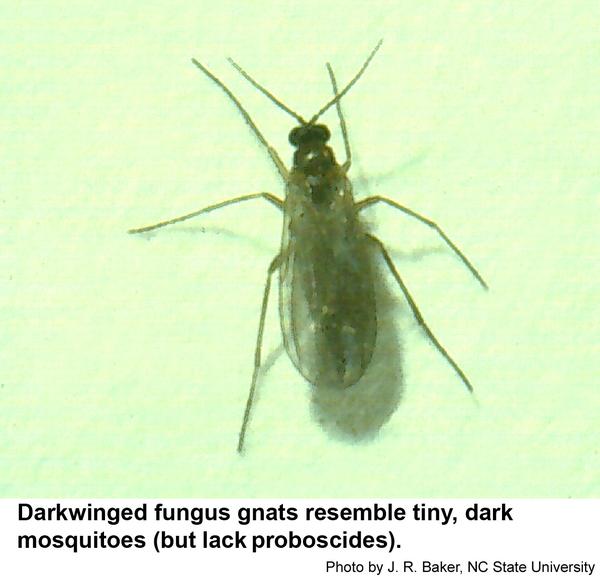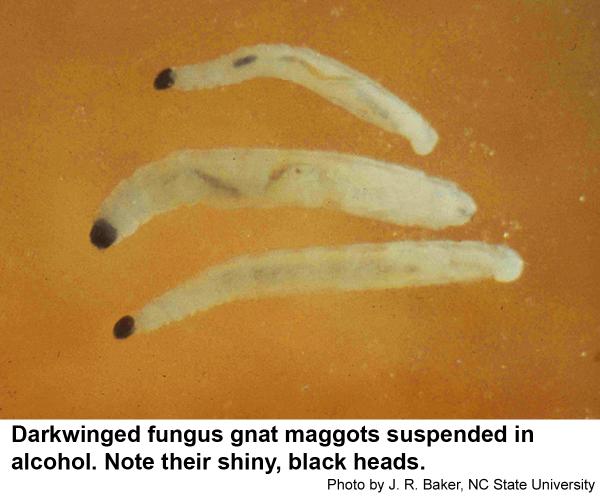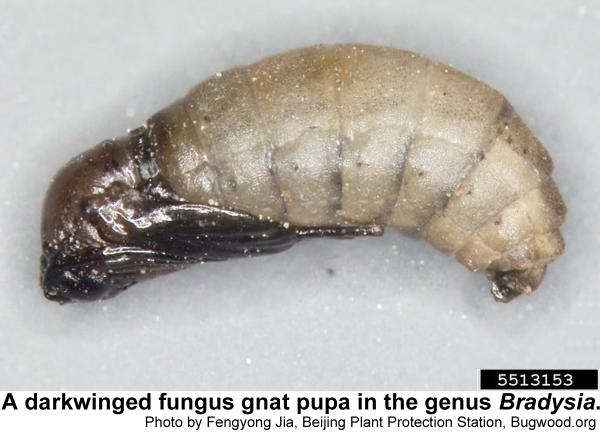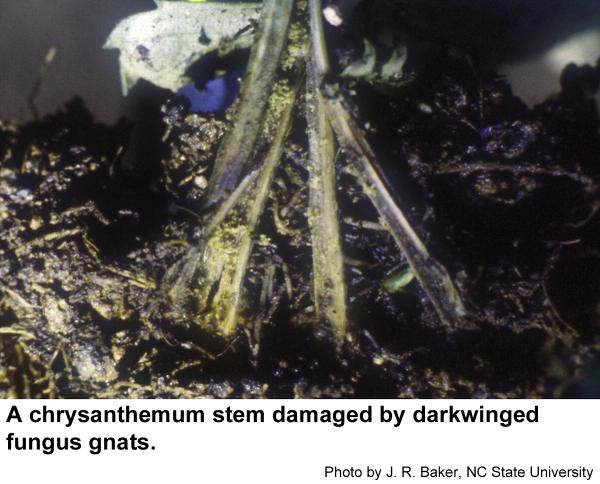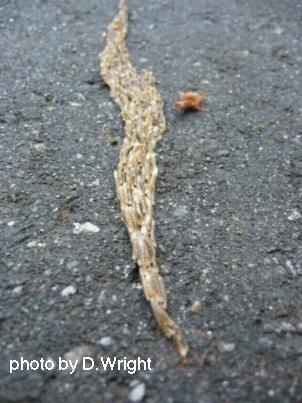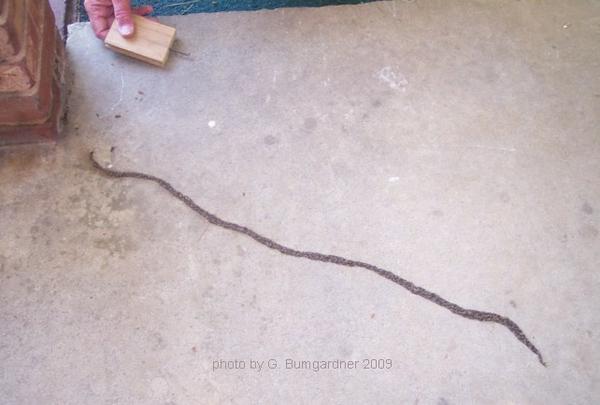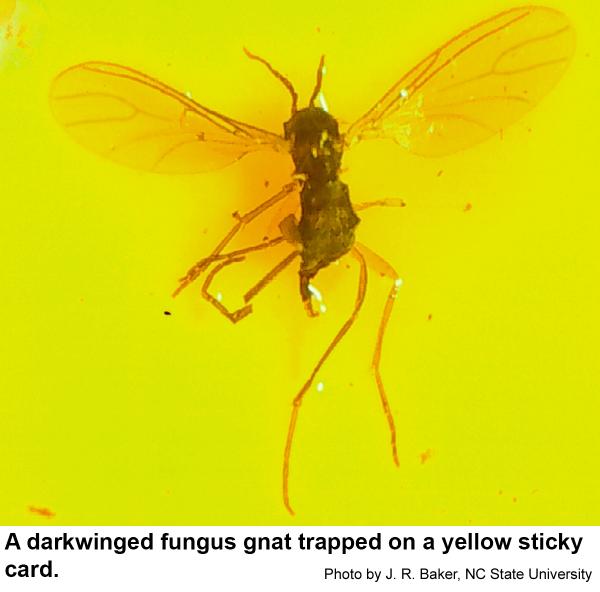General Information
Darkwinged fungus gnats, flies in the genera Lycoriella and Bradysia, are slender with comparatively long legs and antennae. They are grayish-black and about 1⁄8 inch long. These flies crawl about actively on growing medium or fly close to the soil surface. The eggs are yellowish-white and tiny. Darkwinged fungus gnat maggots have shiny black head capsules and white bodies. The last body segment is lobed and helps push the insect along. Mature larvae are about 1⁄4 inch long. Initially white, pupae become dark shortly before the adult emerges.
Biology
Darkwinged fungus gnat maggots feed on the roots of alfalfa, carnations, clover, corn, cucumbers, Easter lilies, geraniums, lettuce, nasturtium, peppers, poinsettias, potatoes, soybeans, wheat, and organic matter throughout the United States. Damage first becomes apparent when plants lose their healthy appearance and wilt. Darkwinged fungus gnat adults are usually noticed before injury caused by the maggots is apparent.
Darkwinged fungus gnat maggots are important pests in some greenhouses and mushroom cellars. Besides the adult nuisance factor, heavy larval populations can damage roots and enter tender stems at soil level. They are also pests of house plants. Several of these flies are of economic concern. In greenhouses, darkwinged fungus gnats are generally most abundant in the winter and spring. Adults and larvae inhabit moist, shady areas. Adults live about 1 week, during which time each female deposits 100 to 150 eggs. They are laid in strings of 3 to 40 on soil, usually near stems of plants. They hatch within 4 days in the greenhouse. There is a tendency for the progeny of each female to be all one gender.
The larvae begin feeding on the root hairs and roots usually in the upper two inches of medium, working their way up the plant and into the stem. However, they also feed on any organic matter in the soil. Being somewhat gregarious, the larvae often form clusters in the soil. They mature in about 14 days, after which they construct a pupal case in the soil made of silk and debris. The pupal stage lasts about 3.5 days. Adults are weak fliers, but they run rapidly on the soil surface.
In turf growing in high organic soils and areas of heavy thatch, darkwinged fungus gnats are occasionally seen in high numbers especially following wet periods. Adjacent natural areas and mulched beds may contribute to the situation. If a large number of eggs hatch near each other and the maggots migrate, they may form a snake-like line crawling atop each other. These are most often noticed when moving across a sidewalk or driveway.
Control
In homes, darkwinged fungus gnat problems can be greatly reduced by avoiding over watering. In the landscape, make sure mulch layers are not too thick (less than 3 inches) and automatic watering systems are not set disregarding soil moisture conditions.
In greenhouse or nursery settings, clean cultural practices and proper watering usually prevent fungus gnat infestations. Repair leaky watering systems and do not allow algal buildup anywhere, not just on the benches. Since fungus gnats prefer potting mixes containing peat moss and abundant moisture, consider using bark mixes and avoid overwatering ornamental plants. Fungus gnats are sometimes introduced in peat moss and plant plugs. Decoy pots of sprouting grain are attractive to females that lay eggs in these pots. Afterwards, the pots should be submerged in boiling water or the contents destroyed in some manner every two weeks to destroy the eggs and maggots. Sticky card traps and fresh potato slices can be used as monitoring tools when used correctly.
In turfgrasses the "snakes" of darkwinged fungus gnat maggots are rarely of any consequence in the landscape, although some homeowners desire control. A pyrethroid lawn and garden spray (permethrin, bifenthrin) is adequate. When used as directed, pyrethroids are very toxic to insects but are not particularly hazardous to humans and pets (other than fish—avoid using pyrethroids around pools, ponds, and streams). For information about controlling fungus gnat adults indoors, see Fungus Gnats Indoors.
Fungus gnats have few efficient natural enemies. A predaceous nematode, Steinernema bibionis, has reduced fungus gnats in mushroom houses 85 percent. Another nematode, Steinernema carpocapsae, is now on the market for fungus gnat control in greenhouses. A small, soil-dwelling predatory mite, Hypoaspis miles, feeds on fungus gnat larvae and is commercially available and compatible with nematodes and Bacillus thuringiensis var.israelensis. Some species of fungus gnats in mushroom houses have developed up to 47-fold resistance to pyrethroid insecticides.
| Pesticide | (Trade Name) | Formulation |
|---|---|---|
| diflubenzuron | (Adept) | Check label for phytotoxcities |
| bifenthrin | (Talstar) | 10% wettable powder |
| cyfluthrin | (Decathlon) | 20% wettable powder |
| kinoprene | (Enstar II) | 65.1% emulsifiable concentrate |
| nematodes, predaceous | (Nemasys, NemAttack, Nema-Globe, Scanmask, etc.) | Various aquaeous solutions |
| pyripoxyfen | (Distance) | Check label for phytotoxcities |
See the North Carolina Agricultural Chemicals Manual for additional choices.
Other Resources
- Common name: darkwinged fungus gnats, scientific name: Bradysia spp. (Insecta: Diptera: Sciaridae). Mead, F. W. and Thomas R. Fasulo. 2006 (revised). Featured Creatures, Entomology & Nematology, FDACS/DPI, EDIS. Publication Number: EENY-215
- Fungus Gnats. Bethke, J. A. and S. H. Dreistadt. 2013 (revised). University of California Agriculture & Natural Resources Statewide IPM Program Publication 7448.
- Fungus Gnats Indoors. Waldvogel, M. and P. Alder. 2016. NC State Extension publications.
- Insect and related Pests of Flowers and Foliage Plants. Baker, J. R., ed. 1994. N.C. State Extension publication AG-136.
- NC State Extension Plant Pathology Publications
- NC State Horticultural Science Publications
For assistance with a specific problem, contact your local Cooperative Extension center.
Publication date: Jan. 1, 2004
Reviewed/Revised: Nov. 24, 2020
N.C. Cooperative Extension prohibits discrimination and harassment regardless of age, color, disability, family and marital status, gender identity, national origin, political beliefs, race, religion, sex (including pregnancy), sexual orientation and veteran status.

